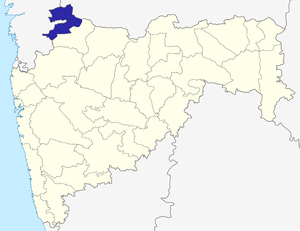Nandurbar (District)
| Nandurbar District | |
|---|---|

|
|
| State | Maharashtra |
| Division : | Nashik |
| Administrative headquarters : | Nandurbar |
| Area : | 5,955 km² |
| Residents : | 1,648,295 |
| Population density : | 277 inhabitants / km² |
| Website : | nandurbar.nic.in |
The district of Nandurbar ( Marathi : नंदुरबार जिल्हा ) is one of 35 districts of the state of Maharashtra in India .
The city of Nandurbar is the administrative seat of the district. The last census in 2011 showed a total population of 1,648,295 people.
history
From pre-Christian times to the year 1345, the area - like the entire region - was ruled by various Buddhist and Hindu rulers. The first state known by name was the Maurya Empire , the last non-Muslim dynasty were the Yadava. After a campaign by the troops of the Delhi Sultanate under the command of Ala-ud-din, the region became tributary to Muslim rulers. In 1318 Muslim armies ravaged the area after the tribute payments had ceased. Various Muslim dynasties ruled from 1345 to 1760 (Tuglukh, Bahmani - effectively their governors, the Farukis - Dekkan sultanates, the Mughals and the Nizam of Hyderabad). With the victory of the Marathas in the Battle of Bhalki, the area came under the rule of the Marathas in 1760 . After the defeat of the Marathas, the colonial era began for the area on June 3, 1818 with the handover to the British East India Company . The district belonged to the Khandesh region , in 1906 by the division of the area to West Khandesh, within the Bombay presidency . The city of Dhule (then Dhulia) became the capital. With India's independence in 1947 and the reorganization of the country, it became part of the new state of Bombay in 1950 . In 1960, Bombay was divided and the area came to the newly created state of Maharashtra. In 1998 the Dhule district split . On July 1, 1998, the new district of Nandurbar emerged from the northern part.
population
Population development
As everywhere in India, the population in the Nandurbar district has been growing rapidly for decades. The growth in the years 2001–2011 was more than 25 percent (25.66%). In those ten years the population increased by nearly 340,000 people. The following table shows the exact numbers:

Significant places
The most populous town in the district is the main town of Nandurbar. Other major cities with a population of more than 10,000 people are Shahade , Nawapur , Talode and Akkalkuwa. The urban population makes up only 16.71 percent of the total population.

Population of the district by confession
A clear vast majority, over 91 percent of the population, are Hindus. The only numerically significant minority are the Muslims. The following table shows the exact religious composition of the population:
| year | Buddhists | Christians | Hindus | Jainas | Muslims | Sikhs | Other | not specified | Total | |||||||||
|---|---|---|---|---|---|---|---|---|---|---|---|---|---|---|---|---|---|---|
| number | % | number | % | number | % | number | % | number | % | number | % | number | % | number | % | Residents | % | |
| 2001 | 5,161 | 0.39% | 17,953 | 1.37% | 1,198,481 | 91.37% | 5,949 | 0.45% | 71,215 | 5.43% | 580 | 0.04% | 7,056 | 0.54% | 5,314 | 0.41% | 1,311,709 | 100.00% |
| Source: 2001 India Census | ||||||||||||||||||
District population by language
The district is a multi-ethnic mix. A relative majority of around 45 percent of the population speaks Bhili / Bhilodi (a Bhil language). There are a number of larger minorities. Significant linguistic minorities with more than 100,000 native speakers are Ahirani (a Khandeshi language) and Marathi. Pawri / Pauri (a Bhil language), Mawchi (a Bhil language), Urdu, Konkani, Gujarati (36,471), Hindi (33,003; with Hindi dialects 80,500 people), Gujrao / Gujrau (a Gujarati language; 26,270) and Banjari (a Hindi dialect; 10,702) are spoken as mother tongues by over 10,000 people each. The following table shows the exact linguistic composition of the population:
| year | Bhili / Bhilodi | Ahirani | Marathi | Pawri / Pauri | Mawchi | Urdu | Konkani | Other | Total | |||||||||
|---|---|---|---|---|---|---|---|---|---|---|---|---|---|---|---|---|---|---|
| number | % | number | % | number | % | number | % | number | % | number | % | number | % | number | % | Residents | % | |
| 2001 | 592.935 | 45.20% | 168,074 | 12.81% | 110,544 | 8.43% | 87,704 | 6.69% | 77,831 | 5.93% | 46,622 | 3.55% | 39,981 | 3.05% | 188.018 | 14.33% | 1,311,709 | 100.00% |
| Source: 2001 India Census | ||||||||||||||||||
Web links
- District website
- Map of the Nandurbar District
- Nandurbar District
- Some background information about the district
- Economy, nature and sights